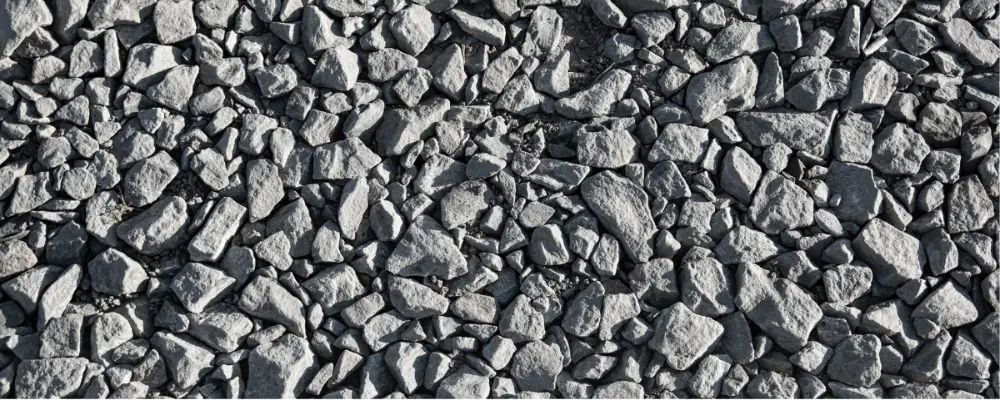Aggregates are essential to the construction industry by providing sturdy, solid, and long-lasting structures made of concrete. Each grade of aggregate has its unique performance and are separated according to their particle size distribution. This guarantees that the structure has uniform particle size distribution. This article will deeply explain the topic of gap-graded aggregate, discussing its characteristics, applications, advantages, and disadvantages, as well as its difference from well-graded aggregates.
What is Gap Graded Aggregate?
Gap-graded aggregate is a mixture of both large and very small-sized aggregates (lack medium-sized ones). The gaps between the larger particles are filled by the smaller ones. This grading decreases the chance of segregation, increases workability, and uses less cement. They are usually used to obtain uniform textures that increase concrete strength and reduce creep and shrinkage.
For low-slump and high-strength concrete used in tunnels, bridges, and tall buildings, gap-graded aggregates are perfect. Decorative concrete finishes also widely utilise these aggregates.
Characteristics of Gap-Graded Aggregate
Particle Distribution: There are observable gaps in the grading curve due to the particle distribution, which is composed of a mixture of large and small particles with few or no medium-sized particles.
Cement Efficiency: Due to the effective particle packing, less cement is required.
Better Workability: By enabling fine particles to fill in spaces in the coarse aggregate, the concrete mix’s workability is improved.
Segregation Risk: May be prone to segregation, particularly in very workable combinations with excess water, necessitating cautious handling.
Particular Uses: Suitable for decorative treatments and low-slump, high-strength concrete used in tunnels and bridges.
Limitations: Not the best for slip-form paving techniques and difficult to pump.
Stockpile Reduction: Promotes cost efficiency by reducing the quantity of aggregate stocks needed.
Applications of Gap-Graded Aggregate
High-Strength Concrete: For the low-slump construction process, gap-graded aggregate is vital due to its high-strength concrete used in tunnels, bridges, and tall skyscrapers.
Decorative Concrete: Due to its distinctive particle arrangement and look, decorative concrete is frequently utilised for ornamental finishes.
Vibration-Responsive Mixes: Concrete mixes that need to be compacted by vibration are best suited for vibration-responsive mixes.
Economical Construction: Lowers cement quantity, which lowers construction costs for major projects.
Specialised Pavements: In certain pavement types where limited workability and high durability are required, specialised pavements are occasionally utilised.
Architectural Applications: Suggested for structural and aesthetic designs that require distinctive textured finishes.
Advantages of Gap-Graded Aggregate
- Between 26% and 40% lesser sand is required for concrete production.
- Since less sand is used, the aggregates’ total surface area is minimised.
- Reduced drying shrinkage can be achieved by preserving point contact between various particle sizes.
- Since the overall void volume is much decreased, less cement is required.
- These aggregates are chosen to optimise the mix by forming spaces that the fine particles can efficiently fill.
Disadvantages of Gap-Graded Aggregate
- Segregation is more likely in blends with high workability.
- Pumping is challenging, which restricts its use in several construction techniques.
- Due to its instability, it is not appropriate for slip-form paving.
- Limited adaptability; best suited for low-slump combinations.
- Strength may be decreased by voids caused by improper compaction.
- Increased complexity as it requires exact proportioning and quality control.
Gap-Graded Aggregate vs. Well-Graded Aggregate
| S.No | Property | Gap-Graded Aggregate | Well-Graded Aggregate |
| 1 | Particle Distribution | Large and small particles with missing intermediates | A continuous range of particle sizes |
| 2 | Cement Usage | Requires less cement due to reduced void volume | Requires more cement to fill smaller voids |
| 3 | Workability | Higher workability in low-slump mixes | Consistent workability across various mixes |
| 4 | Segregation Risk | More prone to segregation in high-slump mixes | Less prone to segregation |
| 5 | Application Suitability | Ideal for decorative concrete and high-strength, low-workability applications | Versatile, general-purpose concrete |
| 6 | Surface Area | Reduces surface area, lowering cement and water demand | Increases surface area for better bonding |
| 7 | Compaction Requirements | Requires extensive vibration for proper compaction | Compacts easily without specialised methods |
Conclusion
To sum up, gap-graded aggregates have several benefits, including better workability, lower cement use, and cost-effectiveness in some applications. They work especially well with decorative treatments and high-strength, low-slump concrete. Their limited suitability for slip-form paving, pumping difficulties, and propensity to segregate must be carefully controlled. With appropriate handling and quality control, gap-graded aggregates can improve the performance and efficiency of concrete mixes; however, they are best utilised in certain situations where their advantages exceed their drawbacks.
FAQs
For the bigger particles, the best materials are crushed stone, gravel, or other long-lasting coarse aggregates; for the smaller particles, the best material is fine sands.
Gap grading enhances concrete strength by improving particle packing, reducing voids, and creating a denser mix. This requires less cement and water while boosting compressive strength. It also improves stability, reduces shrinkage in low-slump mixes, and suits high-strength applications like tunnels, bridges, and large infrastructure projects.
Gap grading is appropriate for building only a few kinds of buildings because of its unique features. Due to its high strength, it is suitable for low-slump concrete applications, including bridges, tunnels, and decorative concrete finishes.
It is not appropriate for general-purpose concrete or projects that need easy workability, like slip-form paving, due to the possibility of segregation. In addition to requiring precise handling, mixing, and vibration techniques, gap-graded concrete is less suitable for large-scale, quick-paced projects where homogeneity in the mix for workability is essential.
Avoiding segregation requires careful management and proper handling. Gap grading can happen with “ordinary” aggregates as well. For instance, particles between 5.00 mm and 2.36 or 1.18 mm sieve widths are frequently absent from very fine sand, which is found in numerous areas. When such sand is used without being combined with coarser sand, a gap-graded aggregate is successfully produced.

